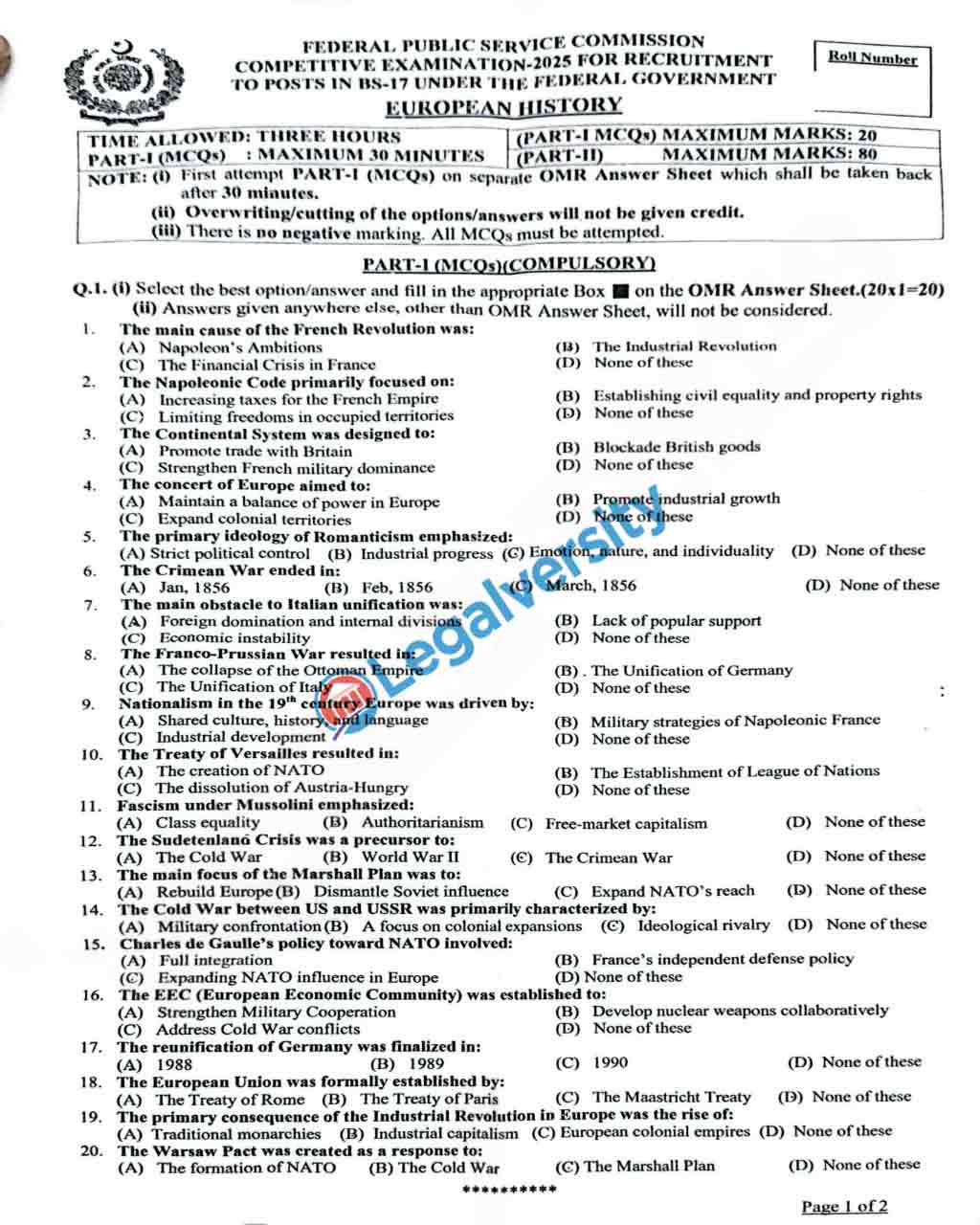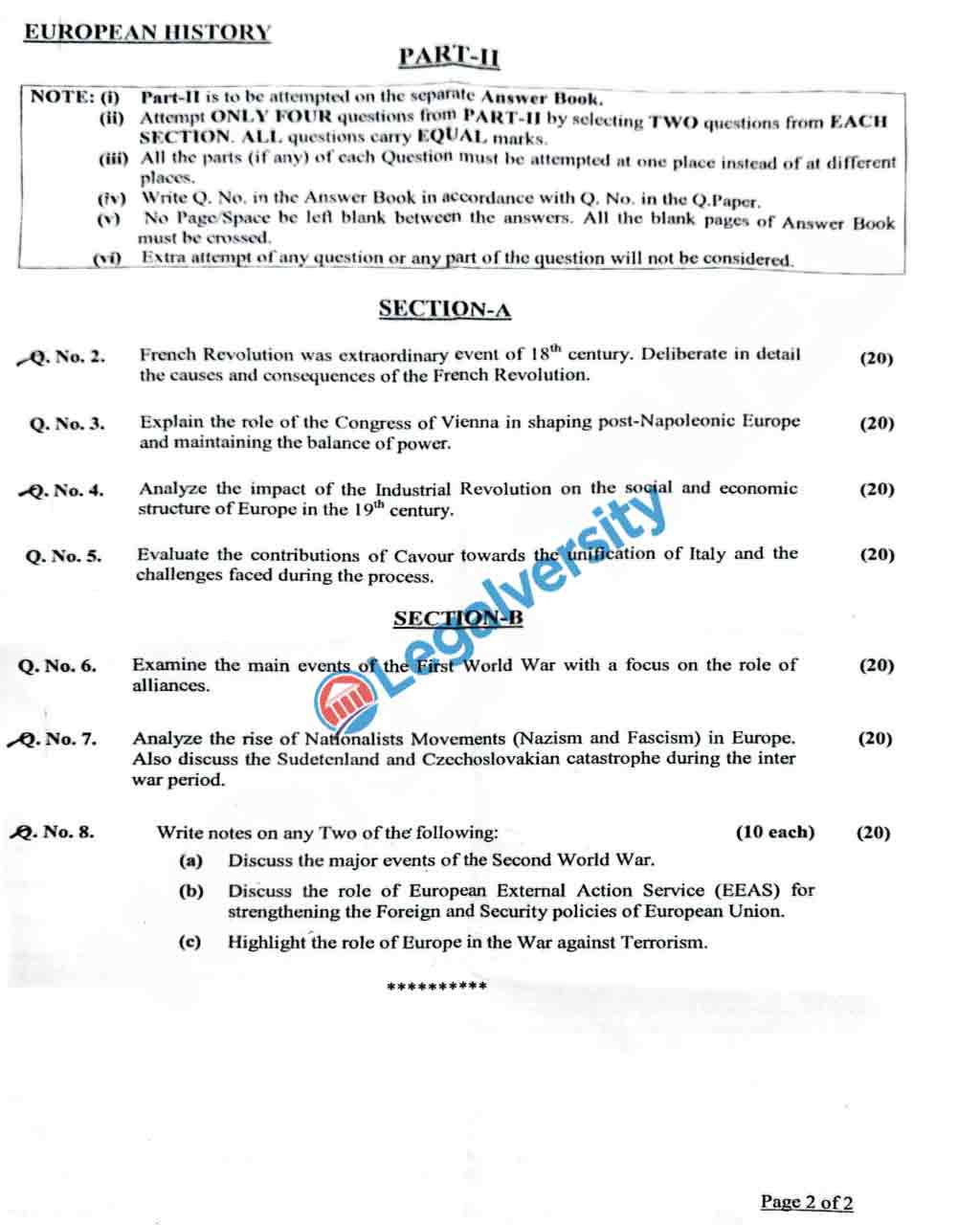The paper on European History is optional in the CSS competitive examination 2025. Here, you will find the CSS European History past Paper 2025. I will also provide a summary of the paper, in which you will analyze what topics were given and how difficult they were. This lets you better understand the concept of paper and prepare well for future examinations.
CSS European History Past Paper 2025
SECTION-A
Q1. The French Revolution was an extraordinary event of the 18th century. Deliberate in detail the causes and consequences of the French Revolution.
Q2. Explain the role of the Congress of Vienna in shaping post-Napoleonic Europe and maintaining the balance of power.
Q3. Analyze the impact of the Industrial Revolution on the social and economic structure of Europe in the 19th century.
Q4. Evaluate the contributions of Cavour towards the unification of Italy and the challenges faced during the process.
SECTION-B
Q5. Examine the main events of the First World War with a focus on the role of alliances.
Q6. Analyze the rise of Nationalists Movements (Nazism and Fascism) in Europe. Also, discuss the Sudentenland and Czechoslovakian catastrophes during the interwar period.
Q7. Write notes on two of the following:
- Discuss the major events of the Second World War.
- Discuss the role of the European External Action Service (EEAS) in strengthening the Foreign and Security policies of the European Union.
- Highlight the role of Europe in the War against Terrorism
Critical Analysis of the Paper
The French Revolution (1789–1799) marked a watershed event in world history, caused by long-standing economic, political, and social inequalities. France’s financial collapse, exacerbated by wasteful spending by the royalty and expensive wars, imposed a crippling burden on the Third Estate. The privileges of nobility and clergy, alongside heavy-handed taxation, created extensive resentment. The influence of thinkers like Rousseau and Voltaire under Enlightenment ideologies spread ideas of liberty and equality, further fuelling revolutionary passion.
The Bastille’s storming in 1789 was the sign of the end of absolute monarchy, which culminated in the execution of King Louis XVI and the elimination of feudalism. Nevertheless, the revolution turned into the Reign of Terror (1793–1794), which was characterized by political cleansing and mass killings. Finally, the turmoil gave birth to Napoleon Bonaparte, who disseminated revolutionary ideas throughout Europe while founding his autocracy. Long-term consequences of the revolution were the propagation of democracy, human rights, and nationalism, which greatly influenced contemporary governance. The Congress of Vienna (1815) was a reactionary attempt at restoring stability following Napoleon’s collapse.
European great powers, led by Austria’s Metternich, Britain’s Castlereagh, and France’s Talleyrand, wanted to reassert monarchies and avoid another upheaval. The congress redrew national borders to contain French aggression and established the Concert of Europe, a system of diplomacy meant to settle disputes and preserve equilibrium between powers. Although this policy successfully contained wars for decades, it also suppressed nationalist and liberal movements, unintentionally planting seeds for revolutions in 1848 and the eventual unification of Germany and Italy.
The 19th-century Industrial Revolution radically changed Europe’s social and economic landscape. The transformation from agrarian economies to industrial production resulted in unprecedented urbanization, large-scale employment, and the emergence of a prosperous bourgeoisie.
Yet, it also introduced onerous labor conditions where workers toiled under long working hours, meager wages, and unsanitary living conditions in congested cities. While industrialization boosted economic growth and increased international trade, it also increased class divisions, which in turn gave birth to socialist and labor movements calling for workers’ rights and improved living conditions. Italy’s unification (1861) was primarily promoted by Count Cavour, who employed diplomacy and strategic partnerships to undermine Austrian control.
While Giuseppe Garibaldi had a revolutionary strategy, Cavour followed a diplomatic and pragmatic approach, aligning alliances with France and Britain and developing economic progress in Piedmont-Sardinia. The task was to bring together a divided Italy, where regional diversities and resistance from the Papacy were obstacles to this unification.
Eventually, the Italian Kingdom was declared in 1861, but political and economic fragmentation lasted for decades. The First World War (1914–1918) was based on complex alliances, militarism, and rivalries between empires. The Triple Entente (Britain, France, Russia) and the Triple Alliance (Germany, Austria-Hungary, Italy) produced an unstable political situation. The assassination of Archduke Franz Ferdinand in 1914 caused a chain reaction, involving major powers in a world war. Trench warfare, huge casualties, and the use of new military technology characterized the war.
The Treaty of Versailles (1919) redrew European borders but imposed harsh penalties on Germany, setting the stage for future conflict. The rise of Nazism and Fascism in the interwar period was fueled by economic hardship, national humiliation, and the fear of communism. In Germany, Hitler’s Nazi Party exploited the Treaty of Versailles’ harsh terms to gain support, while in Italy, Mussolini’s Fascist regime capitalized on national frustration. Their aggressive expansionism brought about crises such as the Sudetenland crisis when Hitler’s occupation of Czechoslovakian land highlighted the vulnerability of appeasement policies.
The inability of the League of Nations to oppose these challenges head-on played a major role in the eruption of World War II. Europe’s contribution to the War on Terror has been complex, with nations engaging in military action, intelligence cooperation, and counterterrorism operations. The challenge is to reconcile national security with human rights, as policies like mass surveillance and tight immigration controls have generated controversy over civil liberties. The European External Action Service (EEAS) is instrumental in framing the EU’s foreign and security policies, facilitating coordinated diplomatic action to international crises.
View the CSS European History past paper 2025


You can also read the CSS Notes and view all previous papers on CSS
